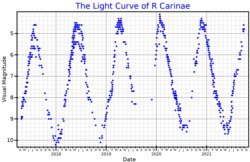R Carinae
Variable star in the constellation Carina From Wikipedia, the free encyclopedia
R Carinae is a double star in the southern constellation of Carina. The brighter component is a variable star that can be viewed with the naked eye at peak brightness,[11] but is usually too faint to be seen without a telescope, having an apparent visual magnitude that fluctuates around 7.43.[6] This star is located at a distance of approximately 600 light years from the Sun based on parallax,[2] and is drifting further away with a radial velocity of +28 km/s.[6]
| Observation data Epoch J2000.0 Equinox J2000.0 | |
|---|---|
| Constellation | Carina |
| Right ascension | 09h 32m 14.59610s[2] |
| Declination | −62° 47′ 20.0026″[2] |
| Apparent magnitude (V) | 3.9 - 10.5[3] |
| Characteristics | |
| Evolutionary stage | AGB[4] |
| Spectral type | M6/7pe[5] |
| B−V color index | 0.906±0.009[6] |
| Variable type | Mira[3] |
| Astrometry | |
| Radial velocity (Rv) | +28.1±1.0[6] km/s |
| Proper motion (μ) | RA: −36.291 mas/yr[2] Dec.: +19.535 mas/yr[2] |
| Parallax (π) | 5.5018±0.3345 mas[2] |
| Distance | 590 ± 40 ly (180 ± 10 pc) |
| Absolute magnitude (MV) | 1.48[6] (at mv = 7.43) |
| Details | |
| Mass | 0.87+0.47 −0.31[4] M☉ |
| Radius | 400±2 (2013)[7] R☉ 581–652 (2018)[8] R☉ 540±50 (2020)[7] R☉ |
| Luminosity | 4,571+1,331 −1,031[4] L☉ |
| Temperature | 2,800[9] K |
| Other designations | |
| R Car, AAVSO 0929-62, CD−62°396, GC 13192, HD 82901, HIP 46806, HR 3816, SAO 250614, CCDM J09322-6247, WDS J09322-6247AB[10] | |
| Database references | |
| SIMBAD | data |
Benjamin Apthorp Gould discovered the variable star, in 1871. It appeared with its variable star designation in Annie Jump Cannon's 1907 work, Second Catalogue of Variable Stars.[12] The main component is an aging red giant star on the asymptotic giant branch[4] with a stellar classification of M6/7pe.[5] It is classified as a pulsating Mira type variable star and its visual brightness varies with an average amplitude of 4.25 magnitudes over a period of 303.99±1.08 d. Its average maximum visual magnitude is 5.05±0.45,[11] but the brightest observed maximum was magnitude 3.9.[3] The pulsations make its size change, in 2014, it was 400 times larger than the Sun, while in 2020 it was 540 times larger.[7] This star is surrounded by a dusty shell, with properties that are consistent with iron-poor silicates or corundum, extending from around three stellar radii outward.[13]
The companion is a magnitude 11.30 star at an angular separation of 2.10″ along a position angle of 132° from the main star, as of 2015.[14]
References
Wikiwand - on
Seamless Wikipedia browsing. On steroids.

